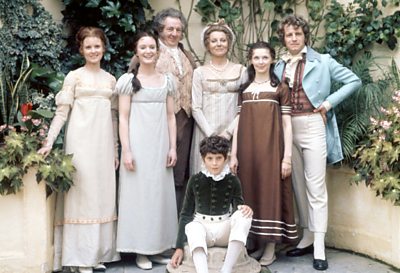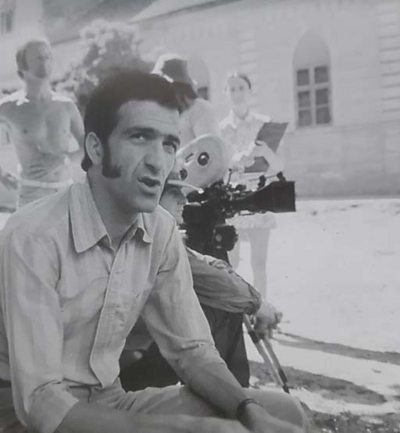As a young television drama director in the 1960s, I was kept busy mining a rich seam of work at the 91Èȱ¬, directing serial adaptations of novels by Emile Zola, Thomas Hardy, Guy de Maupassant, Somerset Maugham, Arnold Bennett and many others.
Early in 1970 I was asked by the producer, David Conroy to consider taking on Tolstoy’s War and Peace, which was to be made in 20 episodes – the length of 10 feature films! The scripts were being written by Jack Pulman, who was later to write the wonderful I Claudius, directed by Herbie Wise, and although War and Peace was to be largely studio based and shot multi-camera, David had already started negotiations with a Belgrade-based film company in Yugoslavia for most of the exteriors and had approached the authorities there for the use of the Yugoslav army in the battle scenes, as filming in Russia would have been out of the question then.
Although feeling over-worked already, I took a deep breath and accepted, with a mixture of dread and sheer excitement at the prospect. I had never read War and Peace and so I was sent home for three months to read, prepare and get fit! The book itself came first, of course, and then what seemed a whole library of associated literature, biographies of Napoleon and Tolstoy, together with as much history as I could absorb in the time.
A recce of our film locations was next on the agenda. Yugoslavia was then, of course, a friendly communist state, Tito was still in power, and it proved to be an excellent choice for our filming: open country in what is now Serbia for our battle scenes, wide rivers and forests, an excellent summer climate but with deep snow in the winter and, last but not least, a cooperative army for the battle scenes. However, there were no grand country estates and houses and although we came across one relic, it was dreadfully rundown, had become the local communist party headquarters and was never to serve our purpose. We needed parkland and grand architecture with rich interiors and large ballrooms but we knew where to go for all that in the UK.
Casting
Back in Shepherd’s Bush, casting got underway; in those days we did this all ourselves, as casting directors were then unknown at the 91Èȱ¬. I knew from the start who I wanted to play Pierre Bezukhov, the central character, as in the previous year I had directed a television play starring the most exciting young actor of that time – Anthony Hopkins. He was absolutely right for Pierre, and he and I already had a good working relationship – but would he commit to such a long assignment? To my delight he accepted immediately and a huge cast of over 160 principals was gradually assembled around him.
We were incredibly lucky with such an extended shoot to sign such names as Rupert Davies, Faith Brook, Joanna David, Alan Dobie, Angela Down and finally our Natasha – Morag Hood. Natasha was crucial – she had to age from 15 to 45, an almost impossible task, and everyone who has read the book has a very clear idea of how she should be.
My designer was Don Homfray, who had worked with me many times before. We were good friends and we knew each other’s work methods. He had literally hundreds of sets to design for the UK studios scenes and a lot of work to do on location in Yugoslavia.
The killing grounds
Our battle scenes called for military advisers and David Conroy found a trio of Sandhurst tutors – military historians Anthony Brett James, David Chandler and Christopher Duffy – who came out to Yugoslavia to check out ‘the killing grounds’, as they called our battle locations. We needed their advice on uniforms, decorations and weapons, while at Sandhurst they schooled us in Napoleonic battle formations and tactics.
Our Russian adviser, found by David, was the 80-year-old Baroness Moura Budberg, who had been married to a high ranking Czarist diplomat and had, we are now told, ‘lived a long life of shadowy entanglements and glamorous liaisons’! She helped us with pronunciation, etiquette and social behaviour, and often came to rehearsals to check up on us. She was a wonderful source of information and full of firsthand stories of her lovers, Maxim Gorky and HG Wells. She had even known Rasputin, and said scornfully ‘I was not impressed with him as a man’.
I have a clear memory of her, enthroned in the rehearsal room surrounded by our young cast at her feet, who were entranced by these magical stories of her Russian past.
David Conroy’s overall plan was to rehearse certain studio sequences and record them at the Television Centre before going out to Yugoslavia to shoot the summer exteriors including the battle scenes. Returning to London, we were then to rehearse and shoot more studio scenes before going out to Yugoslavia again to shoot winter exteriors with deep snow for the Retreat from Moscow. Finally, returning to London, we were to tackle the big ballroom scenes on location before finishing off in the studio.
It was to be a very long haul, and when we were all assembled together for the first time at the initial read-through, in the 91Èȱ¬’s Acton rehearsal rooms, I don’t mind admitting that I was very scared. I was surrounded by a wonderful team though, with the dependable Ken Riddington as my first assistant director by my side, backed up by the hugely supportive Margot Hayhoe and Pat Harrington. As we got into rehearsals, I began to enjoy myself, working with a splendid cast who quickly gave me confidence and made me feel that we were making a good start.
Strategic manoeuvres
The first section of studio recordings was extremely promising and I was thrilled at the performances which were evolving. However, at this advanced stage I was told that the Yugoslav army was not available after all, as there were some strategic manoeuvres and exercises to be performed close to the Romanian border.
I was offered their Territorials instead and flew out to Belgrade to see some of them put through their paces. Would they be disciplined enough? Would they be able to learn the use of the Napoleonic weapons? And would they actually turn up? After this review, I was somewhat disheartened but was persuaded by my bosses to go ahead with them as, at that stage, there was no alternative.
Filming in Yugoslavia began in temperatures around 35 degrees, and with a thousand men we filmed the battles of Borodino and Austerlitz in open country near our base in the little town of Bela Crkva, while the nearby River Danube was our setting for the Treaty of Tilsit. It was tough for us all, particularly walking out to film after lunch into those mid-day temperatures, but undoubtedly worse for the actors in their heavy uniforms and often on horseback as well.
“…organising a thousand men into their costumes when you don’t speak their language is no joke.”
Charles Knode, our costume designer, had the immense task of designing and clothing not only our principal cast but the thousand men of our army and, as he said, ‘organising a thousand men into their costumes when you don’t speak their language is no joke... We had to create an assembly line and then hold a passing out parade!’
Practical working cannon, which could be fired, were made for us in Yugoslavia and were embedded in gun emplacements in the hills above the battlefields. One evening after the shoot, when our scene crew had left, I found myself digging out a gun emplacement for the next day’s shoot with our assistant designer, Jon Pusey. The next evening at dusk we were about to shoot the aftermath of the Battle of Borodino – a wide, open plain littered with the bodies of men, horses and discarded cannon – when a storm blew up with a sky filled with lightning and rain falling gently over our scene. We could not have arranged anything more atmospheric.
The Yugoslav Territorials had performed magnificently and I was reassured by my military advisers that they had been preferable to the young recruits of the Yugoslav Army. Napoleon’s Grand Army was apparently comprised of ‘old sweats’ as well as younger men, and this was also the make up of the Territorials.
We returned to the UK feeling that we had at least made a start, and then began the next block of rehearsals and studio recordings which went well and remained on schedule. Our studio sets, designed by Don Homfray, were magnificent and eventually earned him a well deserved Bafta award. Perhaps the most impressive was his vast interior of the Kremlin in Studio One at the Television Centre. I was astonished when I first walked onto it, and gave a camera to Don to position for the first wide establishing shot.

Snowbound sequences
Returning to Yugoslavia for our snowbound winter sequences, we set up base at Novi Sad on the Danube (in 1999 the target of Nato bombing during the Kosovo War). We had been promised snow, as it had never failed to fall in Novi Sad in January for the previous 20 years. But not, it seemed, in 1972 – and so, after filming for a while with artificial snow, we made the big decision to move the whole unit to Zlatibor, a ski resort nearly 200 miles away.
Having arrived there, we found that there was plenty of snow and it was now very cold indeed. We needed to catch up on lost time after our move, but as the accommodation and food were not of the best, and conditions were so unpleasant, the crew volunteered to work seven days a week and take hot food ‘on the run’ if only to get home sooner!
‘…the crew volunteered to work seven days a week and take hot food ‘on the run’ if only to get home sooner!’
In this unplanned new location we had to stage, among other scenes, the Retreat from Moscow with a thousand men who suddenly had to be found locally. However, we were in luck: it being January, the university students in the area were at home and we managed to assemble the right number. Nevertheless we were faced on the day of the Retreat with bright sunshine and blue skies – a picture postcard was not what I needed. We waited and discussed delaying the shoot for another day – but the expense! But then, quite suddenly, a mist descended over the whole plain and the picture changed completely. Cameras were quickly rolled and the gun was fired to cue the action. We could see nothing for a while until our lighting cameraman, Peter Hall, on the main camera ten feet up was the first to see a thousand men slowly emerging through the mist, a miraculous vision which astounded and genuinely moved us all. They came towards us across the snow, an endless line in ragged uniforms, dragging their carts and wounded, an army in retreat.
Back home in February 1972, we tackled the big ballroom scenes with their orchestras and dancers at Kedleston Hall in Derbyshire and Ragley Hall near Stratford-upon-Avon. Our choreographer was Geraldine Stephenson, who tutored the actors for the dances and worked closely with me to choreograph our cameras into the dances for the actors’ dialogue within the movement. Our final studio recording – the end of it all – was on 9 June 1972, and our last scene was between Pierre and Natasha, now a happily married couple. The scene went wonderfully well and as it finished, I found myself saying ‘Stop recording, let’s check that’ and then, after a pause, having been given the okay from the recordist, ‘Thank you, Studio, that’s it’.
